Abstract
The aim of this work is to investigate the effects of different diesel–bioethanol blended fuels on combustion, engine performance, and emission characteristics in a four-cylinder common rail direct injection (CRDI) diesel engine according to various engine loads. Combustion characteristics including in-cylinder pressure, maximum in-cylinder pressure, heat release rate (HRR), and maximum HRR; engine performance including brake specific fuel consumption (BSFC); and emission characteristics including carbon monoxide (CO), hydrocarbon (HC), nitrogen oxides (NOx), and smoke were compared and analyzed. The four test fuels were diesel (D100), 95% D100 blended with 5% ethanol by volume (D95E5), 90% D100 blended with 10% ethanol by volume (D90E10), and 85% D100 blended with 15% ethanol by volume (D85E15). The results indicated that the addition of ethanol had no great impact on the in-cylinder pressure and HRR, but it could significantly reduce CO, NOx, and smoke emissions. The only deficiency was that BSFC was increased to varying degrees with increase of ethanol due to its low heating value.
1. Introduction
Energy crisis and environmental pollution have always been important issues of widespread concern around the world. With the rapid development of industry, the automobile ownership has remained high. Traditional internal combustion engines (ICE) mainly use fossil fuels as raw materials. According to incomplete statistics, the US recorded oil consumption of 19.4 Mbd in 2019. As Asia’s biggest oil consumer, China’s oil consumption grew 5.1% year-on-year from 13.37 Mbd to 14.05 Mbd. The U.S. alone accounts for approximately 19.76% of the world’s total consumption. The large consumption of fossil fuels has caused environmental changes such as greenhouse effect and abnormal climate. Serious air pollution has had a serious impact on human health. It is reported that the premature death of 5 million people every year are mainly related to particulate pollution in the air [1]. Therefore, developing green and pollution-free clean fuels to replace traditional fossil fuels is of great significance to reduce fossil fuel dependence and environmental pollution.
On the other hand, diesel engines with low fuel consumption, high efficiency characteristics, good economic property, low CO2 emissions, and so on are widely used in medium/heavy vehicles, ships propulsion device, and the electric power facility [2,3]. However, diesel engines emit more nitrogen oxides (NOx) and particulate matter (PM) than gasoline engine, which has posed severe environment problems and thus restrict its development [4,5]. At present, diesel engines mainly reduce NOx and PM emissions through exhaust after-treatment devices such as Selective Catalytic Reduction (SCR) and Diesel Particulate Filters (DPFs), so as to meet increasingly strict emission specifications. Although these post-treatment devices have high emission reduction efficiency, they have many disadvantages, such as high price, regular maintenance, ammonia (NH3) slip, incomplete conversion of NOx, deposit formation, DPF regeneration, etc. [6,7].
Using biodiesel, ethanol, and other biofuels to completely or partially replace diesel can not only reduce the emissions of harmful gases from diesel engines, but also be of great help to achieve global carbon neutrality in the future [8,9]. Biodiesel, as an important alternative fuel for diesel engines, can be obtained from a variety of vegetable oils, waste cooking oil, animal fats, algae, and other raw materials through transesterification [10,11]. It can be directly or indirectly (blended with diesel fuel) used in diesel engines without any modification. Compared with conventional diesel fuel, biodiesel is considered to be a reliable alternative fuel because it has higher lubricity, higher flash point, and better biodegradability. In addition, the oxygen-containing characteristics and high cetane number of biodiesel can not only improve the combustion characteristics of diesel engines, but also reduce the regulated emissions such as carbon monoxide (CO), unburned hydrocarbon (HC) and PM, as well as unregulated emissions such as volatile organic compounds (VOCs), and polycyclic aromatic hydrocarbons (PAHs) [12,13,14]. However, in addition to the advantages of biodiesel, biodiesel’s high viscosity, low volatility, and poor cold flow performance at low temperatures will affect its combustion quality. High viscosity and low volatility will adversely affect fuel atomization, while poor cold flow performance will lead to fatty acid compounds solidification and crystal formation at low temperatures [15]. Other researchers also pointed out that adding biodiesel to diesel engines leads to the increase of NOx, and long-term use of biodiesel will also lead to diesel engine nozzle blockage, rubber ring corrosion, and other problems [10,16].
As another common alternative fuel for ICE, ethanol has higher oxygen content than biodiesel. Moreover, the higher evaporation latent heat characteristics of ethanol can reduce the combustion temperature in the combustion chamber, which is beneficial to reduce NOx [17]. Ethanol is a low-cost alternative fuel with high oxygen content, which can be produced from sugarcane, corn, beet, molasses, cassava root, barley sugar, starch, cellulose, and other raw materials [18]. Its oxygen content is as high as 35%, and it has been used in ethanol diesel (E-diesel) fuel mixture. Compared with diesel fuel, adding ethanol to diesel fuel can significantly reduce the harmful substances such as CO and so emitted by diesel engine. As a highly oxygenated fuel, ethanol can be mixed with diesel (E-diesel) and used in diesel engines. Compared with fossil diesel, the use of ethanol in diesel can significantly reduce PM emissions and reduce toxic gases in exhaust emissions, such as sulfur oxides (SOx) [19].
At present, most of the research on ethanol in diesel engines is using biodiesel–ethanol–diesel (BED) ternary blended fuel. Nadir Yilmaz [20] compared the effects of different biodiesel–methanol–diesel (BMD) and BED blended fuels on the engine performance and emissions of a diesel engine. The results showed that although the addition of methanol and ethanol leads to the increase of brake specific fuel consumption (BSFC), CO, and HC emissions, it significantly reduces the NO emission. Shrivastava et al. [21] studied the engine performance, combustion, and emission characteristics of a single cylinder diesel engine at constant speed 1500 rpm and injection pressure 210 bar. Experiments show that compared with diesel at full load, for the blended fuels, the brake thermal efficiency (BTE) is reduced by about 2%, the BSFC is increased by 3%, the exhaust gas temperature (EGT) is increased by 3%, the CO2 is increased by 0.86%, the HC is reduced by 12 ppm, and the CO and NOx are reduced by 0.029% and 8%, respectively. Pang et al. [19], Yilmaz et al. [22], and Khoobbakht et al. [23] investigated the application characteristics of BED ternary mixed fuel in diesel engines. Most research results show that the cooling effects and oxygen contents of alcohols are two of the most important factors on combustion and emissions from diesel engines.
Through reviewing many previous studies, it is found that there are few studies on the direct use of diesel-ethanol blended fuels on diesel engines. At present, most of the raw materials for preparing biodiesel come from the second generation such as vegetable oils and waste cooking oils. As a result, it is more expensive than bioethanol. Because the raw materials for ethanol production are rich, including many kinds of peel chips and waste biomass, direct use of bioethanol in diesel engines can not only replace some expensive biodiesel, but also play an important role in energy conservation and emission reduction. In addition, it is of great significance to fill the gap in the direct application of bioethanol in diesel engines by focusing on the effects of different concentrations of bioethanol on the combustion and emission characteristics of diesel engines. In general, because bioethanol has a high octane number, it is often used as an antiknock additive in gasoline engines [24]. Since there are few studies on direct use of bioethanol in diesel engines at present, the main motivation of this study is to investigate the application characteristics of direct use of bioethanol in diesel engines and compare the effects of different mixing ratios on combustion, engine performance, and emission characteristics. Therefore, in this paper, combustion, engine performance, and emission characteristics of a four-cylinder common rail direct injection (CRDI) diesel engine running on diesel–ethanol (DE) blended fuels were investigated at a constant engine speed of 1500 rpm with various engine loads. Based on the fact that the combustion and emission characteristics of the diesel engine largely depend on the engine operating conditions and ethanol mixture ratio, this may have a positive and negative impact on the whole. Combining these two influencing factors, this paper focuses on evaluating the potential application of ethanol as an alternative fuel in diesel engines in the future.
2. Materials and Methods
2.1. Test Fuels
In this study, four fuels including diesel (D100), 95% D100 blended with 5% ethanol by volume (D95E5), 90% D100 blended with 10% ethanol by volume (D90E10), and 85% D100 blended with 15% ethanol by volume (D85E15) were used. The fundamental properties of neat diesel and ethanol are presented in Table 1. The commercial diesel fuel with the cetane index of 55.8 is used as the baseline fuel. It is seen that the ethanol has a lower density, viscosity, calorific value, and cetane index compared to the diesel fuel. On the other hand, the addition of ethanol with higher oxygen content can improve the combustion environment of the blends.

Table 1.
Properties of neat diesel and ethanol.
2.2. Experimental Apparatus
The schematic of the experimental set-up is shown in Figure 1. The test engine is a four-cylinder common-rail direct injection (CRDI) diesel engine equipped with a turbocharger and an exhaust gas recirculation (EGR) system without cooler. The four-cylinder diesel engine has a displacement of 1991 cc and a compression ratio of 17.7. The specification of the test engine is shown in Table 2. An eddy current dynamometer (DY-230 kW, Hwanwoong Mechatronics, Gyeongsangnam-do, Korea) was used for controlling the engine speed and the engine load. The series of tests were carried out using diesel and diesel-ethanol blends. Emission characteristics of diesel and diesel-ethanol blends on engine such as CO, HC, and NOx emissions were recorded using a portable exhaust gas analyzer (MEXA-554JKNOx, Horiba, Kyoto, Japan) and a multiple gas analyzer (GreenLine MK2, Eurotron (Korea) Ltd., Seoul, Korea). A partial flow collection analyzer (OP-160, Koeng Co., Ltd., Seoul, Korea) was used to measure particle matter. Combustion pressure for combustion analysis of the combustion chamber was obtained using a piezoelectric pressure sensor (KISTLER Type 6056A, Kistler Korea Co., Ltd., Gyeonggi-do, Korea) at the glow plug position. For analysis of the combustion pressure, data were obtained over an average of 200 cycles. Data acquisition was performed and recorded using a DAQ board (PCI 6040e, National Instrument, Austin, TX, USA).
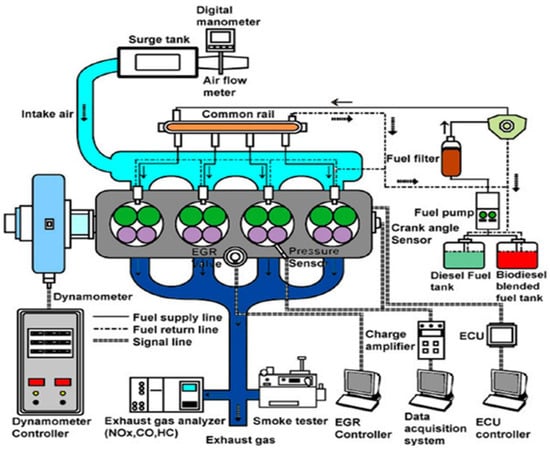
Figure 1.
Schematic of experimental setup.

Table 2.
Specification of test engine.
2.3. Test Conditions
Table 3 lists the engine operating conditions. The experiment was conducted under a constant engine speed of 1500 rpm and three engine loads (30, 60, and 90 Nm). The engine was running without EGR with intake temperature of 30 ± 3 °C. The coolant and lubricant oil temperatures were maintained at 85 ± 3 °C. The fuel injection pressure, pilot, and main injection timing were controlled at 35 MPa, 17, and 7° CA (crack angle) BTDC (before top dead center), respectively. The in-cylinder pressures were recorded for 200 continuous cycles and averaged to calculate the heat-release rate (HRR). Before starting to record the experimental data, the engine runs with diesel at the lowest speed of 750 rpm for 30 min until the temperature of the cooling water reaches a stable temperature of 85 °C. After the engine was warmed up, it was switched to diesel first, followed by D95E5, D90E10, and D85E15.

Table 3.
Test conditions.
3. Results
3.1. Combustion Characteristics
3.1.1. In-Cylinder Pressure
Figure 2 illustrates the in-cylinder pressure curves for the diesel-ethanol binary blended fuels at different engine loads. In order to demonstrate the differences of in-cylinder pressures for different blended fuels, the figures present parts of indicator diagrams for selected parts from 40° CA before top dead center (bTDC) to 40° CA after top dead center (aTDC). As shown in Figure 2, it can be clearly observed that the in-cylinder pressure of all test fuels increases with the increase of engine load, and the combustion starts earlier in terms of the crank angle under high load. This is because the increase of engine load causes more air and fuel to be injected into the combustion chamber. After fuel combustion, the temperature and pressure in the cylinder are increased, and the physical delay of fuel is reduced. In addition, the air flow intensity is also improved, which reduces the retention of excessive residual gas in the cylinder. In a word, the increase of load significantly reduces the ignition delay. A similar trend was also found by Hulwan et al. [25]. On the other hand, with the increase of engine load, the position of the maximum pressure in the cylinder gradually shifts towards aTDC. In Figure 2a, the peak in-cylinder pressure of D100 at 0 Nm, 15 Nm, and 30 Nm is 60.1 bar, 66.1 bar, and 74.3 bar, which occurs at 10° CA aTDC, 12° CA aTDC, and 13° CA aTDC, respectively. In Figure 2b, the peak in-cylinder pressure of D95E5 at 0 Nm, 15 Nm, and 30 Nm is 59.7 bar, 65.7 bar, and 71.7 bar, which occurs at 10° CA aTDC, 12° CA aTDC, and 13° CA aTDC, respectively. In Figure 2c, the peak in-cylinder pressure of D90E10 at 0 Nm, 15 Nm, and 30 Nm is 59.5 bar, 65.9 bar, and 73.7 bar, which occurs at 10° CA aTDC, 12° CA aTDC, and 14° CA aTDC, respectively. In Figure 2d, the peak in-cylinder pressure of D85E15 at 0 Nm, 15 Nm, and 30 Nm is 59.6 bar, 65.4 bar, and 72.3 bar, which occurs at 11° CA aTDC, 12° CA aTDC, and 14° CA aTDC, respectively. This is because the pressure and position in the cylinder mainly depend on the engine operating conditions and fuel properties. The increase of load leads to more fuel injection and the increase of combustion duration, which is the main reason for the shift of the position of the maximum in-cylinder pressure to aTDC.
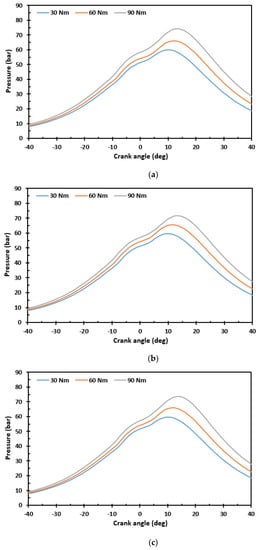
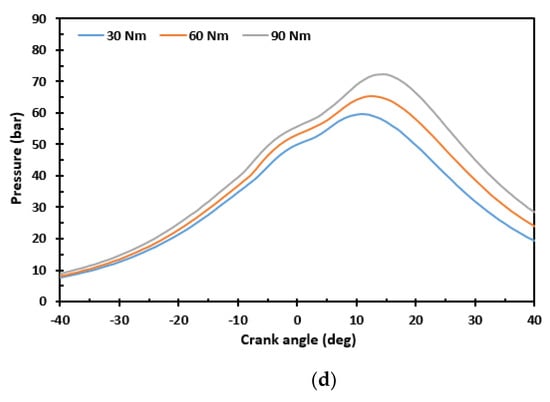
Figure 2.
In-cylinder pressure for (a) D100, (b) D95E5, (c) D90E10, and (d) D85E15.
3.1.2. Maximum In-Cylinder Pressure
Figure 3 shows detailed analysis of maximum pressure in the cylinder for all test fuels according to different engine speeds. As shown in Figure 3, it is obvious that the maximum pressure in the cylinder increases significantly with the increase of engine load. This can be attributed to the increase of load, which leads to more fuel being injected into the combustion chamber and more fuel participating in combustion, thus increasing the maximum pressure in the cylinder. On the other hand, with the addition of ethanol, the maximum pressure in the cylinder does not show a large change under the same load. At 30 Nm, the maximum pressure of D95E5, D90E10, and D85E15 is reduced by 0.67%, 0.99%, and 0.83% compared with that of D100, respectively. At 60 Nm, the maximum pressure of D95E5, D90E10, and D85E15 is reduced by 0.61%, 0.30%, and 1.06% compared with that of D100, respectively. At 90 Nm, the maximum pressure of D95E5, D90E10, and D85E15 is reduced by 3.49%, 0.81%, and 2.69% compared with that of D100, respectively. On the whole, the maximum pressure in the cylinder is slightly reduced by adding ethanol to the diesel fuel only under high load (e.g., 90 Nm), and the maximum pressure is only reduced by 1% at most under low load (e.g., 30 and 60 Nm). This can be attributed to the fact that although the cetane number and calorific value of ethanol are lower than that of diesel (see Table 1), the oxygen content carried by ethanol itself is as high as 35%, which leads to more sufficient oxygen to ensure complete combustion. At higher load, more ethanol is involved in the combustion, and the higher evaporative cooling effect of ethanol plays a major role, resulting in the reduction of the maximum pressure in the cylinder. This is consistent with the results reported by Padala et al. [26]. Overall, the addition of bioethanol did not have a significant impact on the maximum in-cylinder pressures, which may be related to the combined effect of the positive (e.g., high oxygen content) and negative (e.g., low calorific value) properties of bioethanol.
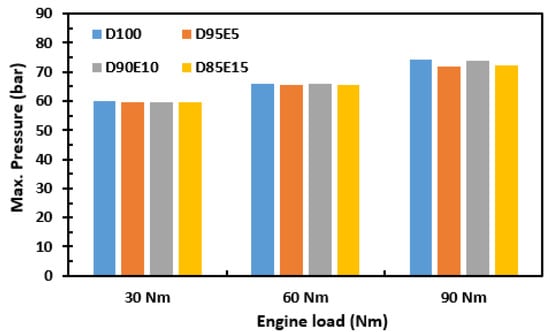
Figure 3.
Maximum in-cylinder pressure for all test fuels according to various engine loads.
3.1.3. Heat Release Rate
Figure 4 shows the variation of heat release rate (HRR) with respect to crank angle for different diesel-ethanol blends at engine speed of 1500 rpm according to different engine loads. As shown in Figure 4, two HRR peaks can be clearly observed, which are caused by pilot injection (start of first injection) and main injection (start of second injection), respectively. For the two-stage injection strategies, the pilot injected fuel is burned first after injection, which increases the temperature and free radical concentration in the cylinder, which is very beneficial to reduce the ignition delay of the main injected fuel. Therefore, the combustion of main injection is mainly controlled by mixing, which is characterized by lower heat release rate than premixed combustion [27]. As shown in Figure 4, the trace of HRR typically presents two phases: one is premixed combustion, and the other is diffusion combustion [28]. In addition, it has been shown that the start of combustion (SOC) is advanced with the increase of engine load. The possible reason for that is that as load increases at extremely lower ranges, the residual gas and wall temperature increase sharply, resulting in higher injection temperatures, thus decreasing ignition delay [29]. On the other hand, with the increase of engine load, the position of the maximum HRR gradually shift towards aTDC. In Figure 4a, the peak HRR of D100 at 0 Nm, 15 Nm, and 30 Nm is 26.79 J/CA, 34.49 J/CA, and 42.27 J/CA, which occurs at 11° CA aTDC, 13° CA aTDC, and 14° CA aTDC, respectively. In Figure 4b, the peak HRR of D100 at 0 Nm, 15 Nm, and 30 Nm is 26.38 J/CA, 32.93 J/CA, and 40.56 J/CA, which occurs at 11° CA aTDC, 12° CA aTDC, and 14° CA aTDC, respectively. In Figure 4c, the peak HRR of D100 at 0 Nm, 15 Nm, and 30 Nm is 26.49 J/CA, 33.94 J/CA, and 43.05 J/CA, which occurs at 11° CA aTDC, 12° CA aTDC, and 14° CA aTDC, respectively. In Figure 4d, the peak HRR of D100 at 0 Nm, 15 Nm, and 30 Nm is 28.42 J/CA, 35.06 J/CA, and 43.60 J/CA, which occurs at 12° CA aTDC, 13° CA aTDC, and 15° CA aTDC, respectively. The reason for this is similar to the in-cylinder pressure mentioned above.
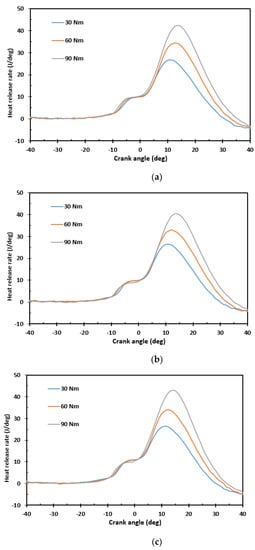
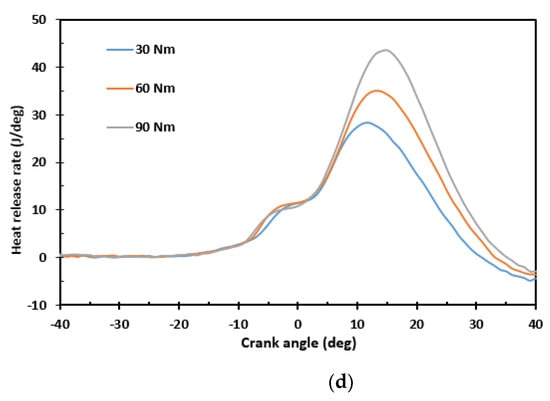
Figure 4.
Heat release rate for (a) D100, (b) D95E5, (c) D90E10, and (d) D85E15.
3.1.4. Maximum Heat Release Rate
Figure 5 shows the maximum value of HRR for all test fuels according to various engine loads. The HRR depends on several factors, such as the calorific value of fuel, combustion quality, equivalence ratio, etc. The increase of HRR indicates that the combustion rate of the charge in the combustion chamber increases [30]. HRR is the main factor affecting the change of cylinder pressure and functional engine parameters, which is regarded as the amount of fuel burned at each step of crankshaft rotation during combustion [31]. As shown in Figure 5, as the engine load increases from 30 Nm to 90 Nm, the maximum HRR of all test fuels shows a gradual increase trend. The average maximum HRR of all test fuels at 60 Nm and 90 Nm is respectively increased by 26.28% and 56.88% compared with that at 30 Nm. This is because more fuel is injected into the combustion chamber, and more fuel combustion produces more heat. On the other hand, on the whole, adding a small amount (e.g., 5 vol.% and 10 vol.%) of ethanol to the diesel leads to a slight decline in peak HRR. For example, the maximum HRR of D95E5 is respectively reduced by 1.55%, 4.53%, and 4.05% at 30 Nm, 60 Nm, and 90 Nm, compared with D100. However, when a large amount of ethanol such as 15 vol.% is added to diesel, the maximum HRR has a different upward trend. For example, the maximum HRR of D85E15 is respectively increased by 6.07%, 1.62%, and 3.14% at 30 Nm, 60 Nm, and 90 Nm, compared with D100. This may be because only when a large amount of ethanol is mixed with diesel for combustion, the high oxygen content in ethanol and evaporative cooling effect can play a major role [28]. Overall, the addition of bioethanol did not have a significant impact on the maximum HRR, which was caused by the same reason as the above in-cylinder pressure.
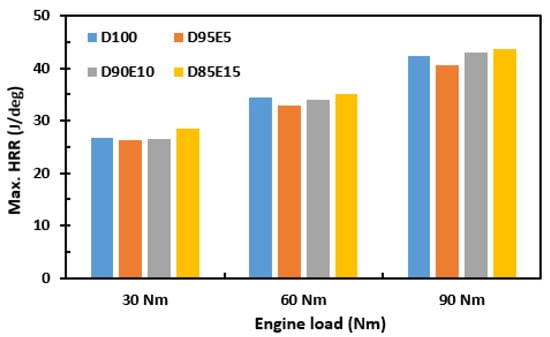
Figure 5.
Maximum heat release rate for all test fuels according to various engine loads.
3.2. Engine Performance
Figure 6 shows the brake specific fuel consumption (BSFC) values for all test fuels at different engine loads. As shown in Figure 6, it is obvious that the BSFC of all test fuels shows a decreasing trend with the increase of engine load. For example, when the engine burns D100, D95E5, D90E10, and D85E15 blended fuels at 60 Nm, the BSFC decreases by 23.58%, 21.89%, 22.97%, and 25.82% compared with 30 Nm, respectively. At 90 Nm, the BSFC of D100, D95E5, D90E10, and D85E15 is decreased by 25.40%, 27.72%, 29.40%, and 32.30% compared with that at 30 Nm, respectively. This can be attributed to the increase of engine load, which leads to the increase of air flow intensity, and the increase of temperature and pressure in the cylinder, which is conducive to the full combustion of fuel and the improvement of combustion efficiency, and finally leads to the reduction of BSFC. Similar results were reported by Fahd et al. [32]. They also pointed out that the reason for the decrease of BSFC is related to the increase of total energy release with the increase of engine load. On the other hand, the BSFC of diesel engines increases with the proportion of ethanol in the fuel blend. At 30 Nm, the BSFC of D95E5, D90E10, and D85E15 is increased by 3.71%, 7.42%, and 12.88% compared with that of D100, respectively. At 60 Nm, the BSFC of D95E5, D90E10, and D85E15 is increased by 6.00%, 8.29%, and 9.57% compared with that of D100, respectively. At 90 Nm, the BSFC of D95E5, D90E10, and D85E15 is increased by 0.49%, 1.66%, and 2.44% compared with that of D100, respectively. This may be mainly related to the low calorific value of ethanol. Increasing the mixing ratio of ethanol in diesel reduces the calorific value of the blended fuel, which requires more fuel to meet the working requirements of the CRDI diesel engine [25].
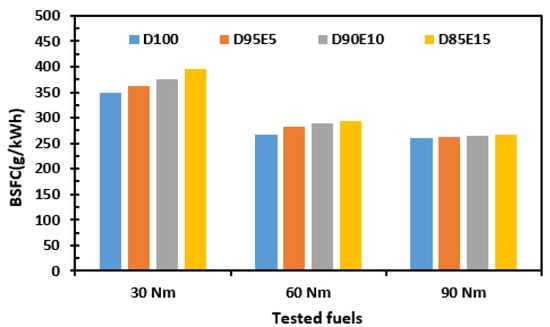
Figure 6.
Maximum heat release rate for all test fuels according to various engine loads.
3.3. Emission Characteristics
3.3.1. CO emissions
Although NOx and smoke are the main harmful emissions emitted from diesel engines, with the gradual strengthening of automobile exhaust emission regulations, CO and HC emissions have also received extensive attention. Therefore, in this study, the impacts of different concentrations of bioethanol on CO, HC, NOx, and PM emissions from a CRDI diesel engine under various loads were compared and investigated. Figure 7 shows the CO emissions for all test fuels according to different engine speeds. CO emission is mainly caused by incomplete combustion of fuel caused by insufficient oxygen. As shown in Figure 7, it can be clearly seen that CO of all test fuels shows a decreasing trend with the increase of engine load. At 60 Nm, the CO of D100, D95E5, D90E10, and D85E15 is decreased by 33.48%, 37.33%, 36.12%, and 40.76% compared with that at 30 Nm, respectively. At 90 Nm, the CO of D100, D95E5, D90E10, and D85E15 is decreased by 8.48%, 28.57%, 31.67%, and 31.09% compared with that at 30 Nm, respectively. This is because the increase of load leads to the increase of temperature and pressure in the cylinder, which is conducive to the oxidation reaction of CO [27]. On the other hand, the addition of ethanol also reduces CO emissions as a whole, compared with diesel fuel. Especially under high load, the reduction of CO is the largest. For example, at 90 Nm, the CO of D95E5, D90E10, and D85E15 is decreased by 28.24%, 30.09%, and 24.07% compared with that of D100, respectively. This is because more air and fuel enter the cylinder under higher load, resulting in higher combustion temperature and accelerating the oxidation of CO. In addition, ethanol is an oxygenated fuel, which further promotes complete combustion [33].
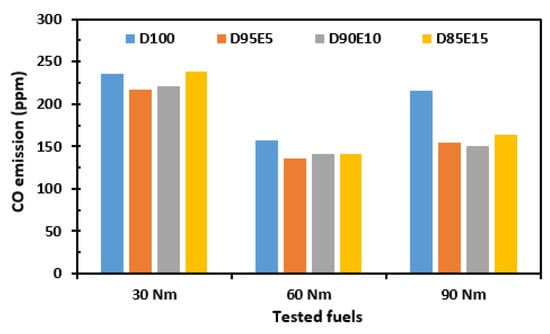
Figure 7.
CO emissions for all test fuels according to various engine loads.
3.3.2. HC Emissions
Figure 8 shows the results of HC emissions for all test fuels under different engine loads. HC is an important parameter for determining the emission behavior of the engines [27]. From Figure 8, on the whole, HC of most test fuels decreases with the increase of engine load and increases with the increase of ethanol mixture ratio. For example, at 60 Nm, the HC emission of D100, D95E5, D90E10, and D85E15 is reduced by 0.00%, 18.18%, 7.14%, and 14.29% compared with that at 30 Nm, respectively. At 30 Nm, the HC emission of D95E5, D90E10, and D85E15 is increased by 37.5%, 75.00%, and 75.00% compared with that of D100, respectively. Under low load, the diesel engine emits the most HC. This is mainly because the lower cylinder temperature under low load is not conducive to fuel combustion. In addition, ethanol has evaporative cooling effect, which further reduces the temperature in the cylinder and forms more misfire areas, resulting in more HC generation [34]. Park et al. [35] also reported that the addition of ethanol leads to an increase in HC compared with the use of neat diesel fuel. In addition, they also pointed out that the HC emissions arise due to wall wetting, insufficient oxygen, and residual fuel in the sac volume.
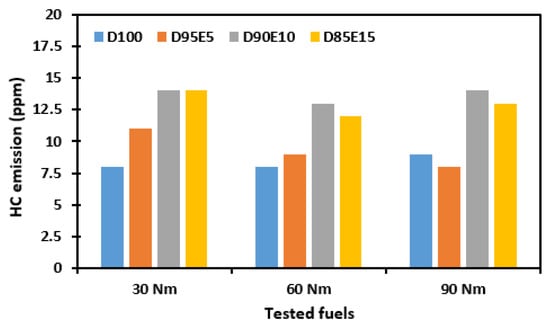
Figure 8.
HC emissions for all test fuels according to various engine loads.
3.3.3. NOx Emissions
Figure 9 shows the variation of NOx emissions for all test fuels according to different engine loads. It can be clearly seen that NOx emissions of all fuels shows an obvious increasing trend with the engine load increasing from 30 to 90 Nm. At 60 Nm, the NOx emission of D100, D95E5, D90E10, and D85E15 is increased by 78.11%, 72.47%, 72.22%, and 92.11% compared with that at 30 Nm, respectively. At 90 Nm, the NOx emission of D100, D95E5, D90E10, and D85E15 is increased by 168.24%, 164.52%, 186.67%, and 207.89% compared with that at 30 Nm, respectively. However, on the other hand, with the addition of ethanol to the diesel fuel, the NOx emission of all diesel-ethanol blended fuels shows a decreasing trend under most load conditions. For example, at 30 Nm, the NOx emission of D95E5, D90E10, and D85E15 is decreased by 0.22%, 3.43%, and 18.46% compared with that of D100, respectively. At 60 Nm, the NOx emission of D95E5, D90E10, and D85E15 is decreased by 3.37%, 6.63%, and 12.05% compared with that of D100, respectively. This is because the formation of NOx largely depends on the high temperature, oxygen enrichment, and sufficient duration in the cylinder. Under low load, short combustion duration and low cylinder temperature are not conducive to the formation of NOx. With the increase of engine load, the fuel injected into the cylinder increases, and the combustion temperature and combustion duration increase in the cylinder, resulting in an increase in NOx emissions [36]. In addition, the main reason for the reduction of NOx caused by the addition of ethanol may be related to the high evaporation latent heat of ethanol. The cooling effect of ethanol may reduce the combustion temperature in the cylinder, thereby reducing the formation of NOx [27].
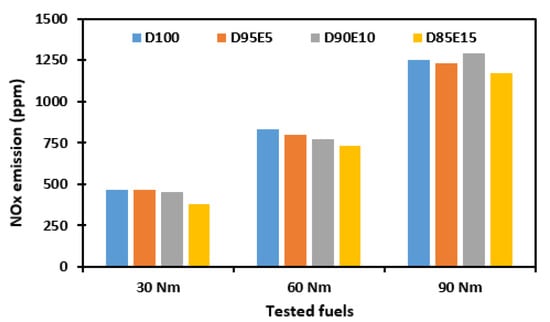
Figure 9.
NOx emissions for all test fuels according to various engine loads.
3.3.4. Smoke Emissions
Figure 10 shows the smoke emissions of all test fuels according to different engine loads. It can be clearly seen that smoke emissions of all fuels shows an obvious increasing trend with the engine load increasing from 30 to 90 Nm. At 60 Nm, the smoke emission of D100, D95E5, D90E10, and D85E15 is increased by 34.55%, 4.17%, 2.33%, and 0.00% compared with that at 30 Nm, respectively. At 90 Nm, the smoke emission of D100, D95E5, D90E10, and D85E15 is increased by 150.91%, 125.00%, 104.65%, and 148.00% compared with that at 30 Nm, respectively. The higher the load, the more smoke emission is mainly because the increase of load leads to more fuel being injected into the combustion chamber, reducing the air-fuel ratio and increasing the fuel rich areas [33,34]. On the other hand, with the addition of ethanol to diesel fuel, the smoke emission of all blended fuels shows a gradually decreasing trend compared with that of diesel fuel. At 30 Nm, the smoke emission of D95E5, D90E10, and D85E15 is decreased by 12.73%, 21.82%, and 54.55% compared with that of D100, respectively. At 60 Nm, the smoke emission of D95E5, D90E10, and D85E15 is decreased by 32.43%, 40.54%, and 66.22% compared with that of D100, respectively. At 90 Nm, the smoke emission of D95E5, D90E10, and D85E15 is decreased by 21.74%, 36.23%, and 55.07% compared with that of D100, respectively. This can be attributed to the fact that ethanol is a highly oxygenated fuel, which improves the problem of local hypoxia and promotes the complete combustion. In addition, the evaporation latent heat effect of ethanol and low cetane number will increase the ignition delay, which can provide enough time for fuel and air to form a uniform mixture [34]. Moreover, what is exciting is that the addition of bioethanol can not only reduce smoke emissions from the CRDI diesel engine, but also reduce NOx (see Table 4). In general, the NO and smoke emitted by diesel engines have a contradictory relationship (often called as trade-off relationship), that is, when the fuel is fully combusted, the higher temperature in the combustion chamber results in more NOx generation, and the carbon particles are also fully combusted and oxidized, resulting in less smoke generation. However, in this study, bioethanol not only has a high oxygen content to promote the full combustion of fuel, but also has a high latent heat to curb the rise of temperature in the combustion chamber.
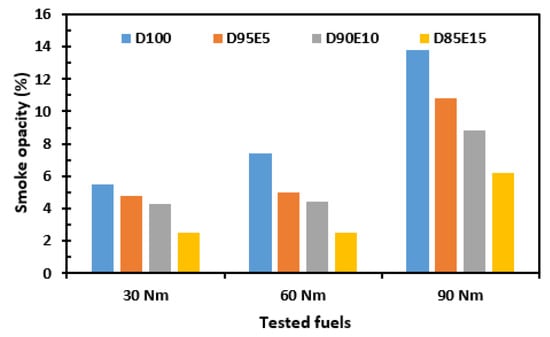
Figure 10.
Smoke emissions for all test fuels according to various engine loads.

Table 4.
Addition of bioethanol improved improve the NOx-smoke trade-offs (“−“ indicates decrease, “+” indicates increase, compared with diesel).
4. Conclusions
In this work, a comparative study on the effects of different diesel–ethanol blended fuels on combustion, engine performance, and emission characteristics were investigated in a four-cylinder common rail direct injection (CRDI) diesel engine. The main conclusions are as follows:
- (1)
- For the combustion characteristics, the increase of engine load significantly increases the pressure and heat release rate (HRR) in the cylinder, and the start of combustion is also advanced. The addition of ethanol has no significant effect on in-cylinder pressure and HRR. Under most experimental conditions, the in-cylinder pressure is only reduced by 1%. In addition, only 15 vol.% ethanol with high mixture ratio causes a slight increase in HRR.
- (2)
- For the engine performance, the increase of engine load significantly decreases the brake specific fuel consumption (BSFC). The BSFC is reduced by 32.30% at most when 15 vol.% ethanol is added to diesel fuel at 90 Nm. On the other hand, the addition of ethanol leads to the increase of BSFC in varying degrees. The BSFC is increased by 12.88% at most when 15 vol.% ethanol is added to diesel fuel at 30 Nm.
- (3)
- For the emission characteristics, although the increase of engine load is beneficial to the reduction of carbon monoxide (CO) and unburned hydrocarbon (HC), it increases nitrogen oxides (NOx) and smoke. Surprisingly, the addition of ethanol significantly reduced CO, NOx, and smoke. The CO is reduced by up to 30.09% when 10 vol.% ethanol is added to diesel fuel at 90 Nm. The NOx is reduced by up to 18.46% when 15 vol.% ethanol is added to diesel fuel at 30 Nm. The smoke is reduced by up to 66.22% when 15 vol.% ethanol is added to diesel fuel at 60 Nm.
In the future work, a wider range of operating conditions such as injection timings, injection pressures, and idle speeds will be compared to study the combustion and emissions of diesel engines direct fueled with bioethanol with different concentrations. In addition, whether the addition of biodiesel will also be studied as an important base-line data.
Funding
This research received no external funding.
Institutional Review Board Statement
Not applicable.
Informed Consent Statement
Not applicable.
Data Availability Statement
Not applicable.
Conflicts of Interest
The authors declare no conflict of interest.
References
- Martins, T.; Barreto, A.C.; Souza, F.M.; Souza, A.M. Fossil fuels consumption and carbon dioxide emissions in G7 countries: Empirical evidence from ARDL bounds testing approach. Environ. Pollut. 2021, 291, 118093. [Google Scholar] [CrossRef] [PubMed]
- Asad, U.; Divekar, P.S.; Zheng, M. High efficiency ethanol–diesel dual-fuel combustion: Analyses of performance, emissions and thermal efficiency over the engine load range. Fuel 2022, 310, 122397. [Google Scholar] [CrossRef]
- Ge, J.C.; Wu, G.; Choi, N.J. Comparative study of pilot–main injection timings and diesel/ethanol binary blends on combustion, emission and microstructure of particles emitted from diesel engines. Fuel 2022, 313, 122658. [Google Scholar] [CrossRef]
- Singh, D.; Subramanian, K.; Singal, S.K. Emissions and fuel consumption characteristics of a heavy duty diesel engine fueled with hydroprocessed renewable diesel and biodiesel. Appl. Energy 2015, 155, 440–446. [Google Scholar] [CrossRef]
- Pan, M.; Zheng, Z.; Huang, R.; Zhou, X.; Huang, H.; Pan, J.; Chen, Z.P. Reduction in PM and NOX of a diesel engine integrated with n-octanol fuel addition and exhaust gas recirculation. Energy 2019, 187, 115946. [Google Scholar] [CrossRef]
- Sadashiva, P.S. A Review on Selective Catalytic Reduction (SCR)—A Promising Technology to Mitigate NOx of Modern Automobiles; Presidency University: Kolkata, India, 2018. [Google Scholar]
- Meng, Z.; Chen, C.; Li, J.; Fang, J.; Tan, J.; Qin, Y.; Jiang, Y.; Qin, Z.; Bai, W.; Liang, K. Particle emission characteristics of DPF regeneration from DPF regeneration bench and diesel engine bench measurements. Fuel 2020, 262, 116589. [Google Scholar] [CrossRef]
- Mariappan, M.; Panithasan, M.S.; Venkadesan, G. Pyrolysis plastic oil production and optimisation followed by maximum possible replacement of diesel with bio-oil/methanol blends in a CRDI engine. J. Clean. Prod. 2021, 312, 127687. [Google Scholar] [CrossRef]
- Gnanamoorthi, V.; Devaradjane, G. Effect of compression ratio on the performance, combustion and emission of DI diesel engine fueled with ethanol—Diesel blend. J. Energy Inst. 2015, 88, 19–26. [Google Scholar] [CrossRef]
- Ge, J.C.; Yoon, S.K.; Choi, N.J. Using canola oil biodiesel as an alternative fuel in diesel engines: A review. Appl. Sci. 2017, 7, 881. [Google Scholar] [CrossRef]
- Wen, Z.; Johnson, M.B. Microalgae as a Feedstock for Biofuel Production. 2009. Available online: https://vtechworks.lib.vt.edu/bitstream/handle/10919/48544/442-886_pdf.pdf?sequence=1 (accessed on 30 September 2022).
- Ge, J.C.; Kim, H.Y.; Yoon, S.K.; Choi, N.J. Reducing volatile organic compound emissions from diesel engines using canola oil biodiesel fuel and blends. Fuel 2018, 218, 266–274. [Google Scholar] [CrossRef]
- Kuti, O.A.; Zhu, J.; Nishida, K.; Wang, X.; Huang, Z. Characterization of spray and combustion processes of biodiesel fuel injected by diesel engine common rail system. Fuel 2013, 104, 838–846. [Google Scholar] [CrossRef]
- Borillo, G.C.; Tadano, Y.S.; Godoi, A.F.L.; Pauliquevis, T.; Sarmiento, H.; Rempel, D.; Yamamoto, C.I.; Marchi, M.R.R.; Potgieter-Vermaak, S.; Godoi, R.H.M. Polycyclic Aromatic Hydrocarbons (PAHs) and nitrated analogs associated to particulate matter emission from a Euro V-SCR engine fuelled with diesel/biodiesel blends. Sci. Total Environ. 2018, 644, 675–682. [Google Scholar] [CrossRef] [PubMed]
- Wei, L.; Cheung, C.S.; Ning, Z. Effects of biodiesel-ethanol and biodiesel-butanol blends on the combustion, performance and emissions of a diesel engine. Energy 2018, 155, 957–970. [Google Scholar] [CrossRef]
- Ge, J.C.; Kim, H.Y.; Yoon, S.K.; Choi, N.J. Optimization of palm oil biodiesel blends and engine operating parameters to improve performance and PM morphology in a common rail direct injection diesel engine. Fuel 2020, 260, 116326. [Google Scholar] [CrossRef]
- Ge, J.C.; Wu, G.; Yoo, B.-O.; Choi, N.J. Effect of injection timing on combustion, emission and particle morphology of an old diesel engine fueled with ternary blends at low idling operations. Energy 2022, 253, 124150. [Google Scholar] [CrossRef]
- Shahir, S.A.; Masjuki, H.H.; Kalam, M.A.; Imran, A.; Fattah, I.M.R.; Sanjid, A. Feasibility of diesel–biodiesel–ethanol/bioethanol blend as existing CI engine fuel: An assessment of properties, material compatibility, safety and combustion. Renew. Sustain. Energy Rev. 2014, 32, 379–395. [Google Scholar] [CrossRef]
- Pang, X.; Shi, X.; Mu, Y.; He, H.; Shuai, S.; Chen, H.; Li, R. Characteristics of carbonyl compounds emission from a diesel-engine using biodiesel–ethanol–diesel as fuel. Atmos. Environ. 2006, 40, 7057–7065. [Google Scholar] [CrossRef]
- Yilmaz, N. Comparative analysis of biodiesel–ethanol–diesel and biodiesel–methanol–diesel blends in a diesel engine. Energy 2012, 40, 210–213. [Google Scholar] [CrossRef]
- Shrivastava, K.; Thipse, S.S.; Patil, I.D. Optimization of diesel engine performance and emission parameters of Karanja biodiesel-ethanol-diesel blends at optimized operating conditions. Fuel 2021, 293, 120451. [Google Scholar] [CrossRef]
- Yilmaz, N.; Vigil, F.M.; Donaldson, A.B.; Darabseh, T. Investigation of CI engine emissions in biodiesel–ethanol–diesel blends as a function of ethanol concentration. Fuel 2014, 115, 790–793. [Google Scholar] [CrossRef]
- Khoobbakht, G.; Karimi, M.; Kheiralipour, K. Effects of biodiesel-ethanol-diesel blends on the performance indicators of a diesel engine: A study by response surface modeling. Appl. Therm. Eng. 2019, 148, 1385–1394. [Google Scholar] [CrossRef]
- Nanlohy, H.Y.; Arief, S.; Riupassa, H.; Mini, M.; Trismawati, T.; Panithasan, M.S. Gasohol Engine Performance with Various Ignition Timing. J. Mech. Eng. Sci. Technol. JMEST 2022, 6, 48–55. [Google Scholar] [CrossRef]
- Hulwan, D.B.; Joshi, S.V. Performance, emission and combustion characteristic of a multicylinder DI diesel engine running on diesel–ethanol–biodiesel blends of high ethanol content. Appl. Energy 2011, 88, 5042–5055. [Google Scholar] [CrossRef]
- Padala, S.; Woo, C.; Kook, S.; Hawkes, E.R. Ethanol utilisation in a diesel engine using dual-fuelling technology. Fuel 2013, 109, 597–607. [Google Scholar] [CrossRef]
- Qi, D.H.; Yang, K.; Zhang, D.; Chen, B.; Wei, Q.; Zhang, C.H. Experimental investigation of a turbocharged CRDI diesel engine fueled with Tung oil-diesel-ethanol microemulsion fuel. Renew. Energy 2017, 113, 1201–1207. [Google Scholar] [CrossRef]
- Chen, Z.; He, J.; Chen, H.; Geng, L.; Zhang, P. Comparative study on the combustion and emissions of dual-fuel common rail engines fueled with diesel/methanol, diesel/ethanol, and diesel/n-butanol. Fuel 2021, 304, 121360. [Google Scholar] [CrossRef]
- Mustayen, A.G.M.B.; Wang, X.; Rasul, M.G.; Hamilton, J.M.; Negnevitsky, M. Thermodynamic analysis of diesel engine ignition delay under low load conditions. Energy Rep. 2022, 8, 495–501. [Google Scholar] [CrossRef]
- Paul, A.; Panua, R.; Debroy, D. An experimental study of combustion, performance, exergy and emission characteristics of a CI engine fueled by Diesel-ethanol-biodiesel blends. Energy 2017, 141, 839–852. [Google Scholar] [CrossRef]
- Jamrozik, A. The effect of the alcohol content in the fuel mixture on the performance and emissions of a direct injection diesel engine fueled with diesel-methanol and diesel-ethanol blends. Energy Convers. Manag. 2017, 148, 461–476. [Google Scholar] [CrossRef]
- Fahd, M.E.A.; Wenming, Y.; Lee, P.S.; Chou, S.K.; Yap, C.R. Experimental investigation of the performance and emission characteristics of direct injection diesel engine by water emulsion diesel under varying engine load condition. Appl. Energy 2013, 102, 1042–1049. [Google Scholar] [CrossRef]
- Senthilraja, R.; Sivakumar, V.; Thirugnanasambandham, K.; Nedunchezhian, N. Performance, emission and combustion characteristics of a dual fuel engine with Diesel–Ethanol—Cotton seed oil Methyl ester blends and Compressed Natural Gas (CNG) as fuel. Energy 2016, 112, 899–907. [Google Scholar] [CrossRef]
- Kumar, M.S.; Kerihuel, A.; Bellettre, J.; Tazerout, M. Ethanol animal fat emulsions as a diesel engine fuel–part 2: Engine test analysis. Fuel 2006, 85, 2646–2652. [Google Scholar] [CrossRef]
- Park, S.H.; Youn, I.M.; Lee, C.S. Influence of ethanol blends on the combustion performance and exhaust emission characteristics of a four-cylinder diesel engine at various engine loads and injection timings. Fuel 2011, 90, 748–755. [Google Scholar] [CrossRef]
- Zhang, Z.; Li, J.; Tian, J.; Dong, R.; Zou, Z.; Gao, S.; Tan, D. Performance, combustion and emission characteristics investigations on a diesel engine fueled with diesel/ ethanol /n-butanol blends. Energy 2022, 249, 123733. [Google Scholar] [CrossRef]
Publisher’s Note: MDPI stays neutral with regard to jurisdictional claims in published maps and institutional affiliations. |
© 2022 by the author. Licensee MDPI, Basel, Switzerland. This article is an open access article distributed under the terms and conditions of the Creative Commons Attribution (CC BY) license (https://creativecommons.org/licenses/by/4.0/).